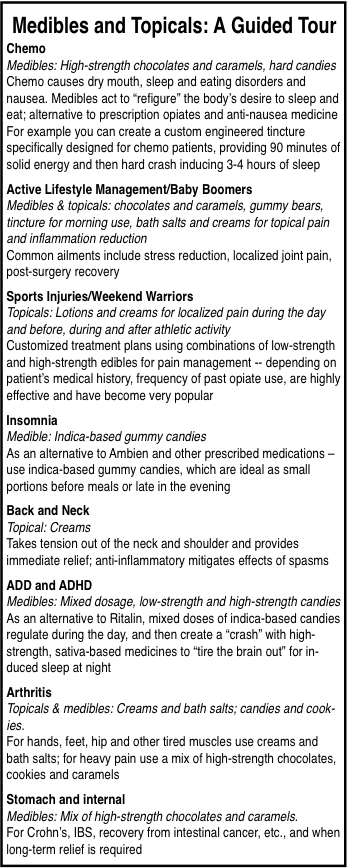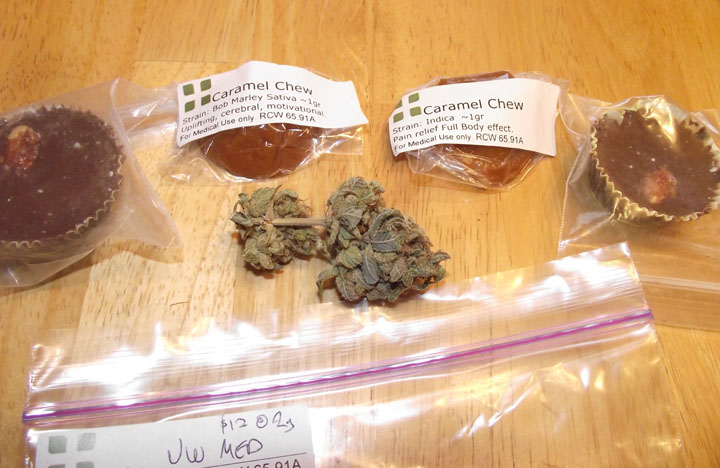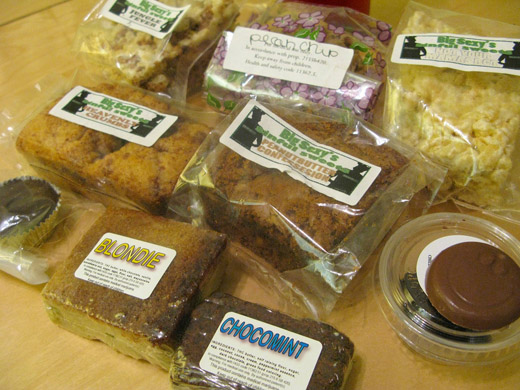Your cart is currently empty!
Granny’s Little Helper: Medibles Take Stigma From Medical Cannabis
Reprinted with permission from Toke of the Town
Edible cannabis medicine is highly effective and can be engineered to fight specific and highly targeted ailments and symptoms
Treatment Trends
By Ben Reagan
Co-Founder, The C.P.C
Grandma may not smoke a joint to relieve chronic arthritis pain, but she sure does enjoy her pumpkin pie pastry pop that not only tastes great but also provides her with hours of daily, pain-free relief for her hands and fingers. On other days she eats her bacon and cheddar cheese pastry pop.
That does sound yummy, but hold on: a pastry pop?
 That’s right, as the medical marijuana industry quickly matures one great outcome for patients are the development of better and more efficacious products, such as smoke-free medibles that come in many shapes and forms such as pastries, caramels, candies, cookies and tinctures.
That’s right, as the medical marijuana industry quickly matures one great outcome for patients are the development of better and more efficacious products, such as smoke-free medibles that come in many shapes and forms such as pastries, caramels, candies, cookies and tinctures.
Simply put, medibles are specific strains of cannabis packed into edibles, resulting in a longer duration and a deeper, body side effect — without the up and downs associating with needing to frequently medicate via smoking.
Even more important, patients are also finding that medibles compare favorably to providing the desired, pain-mitigating effects from taking a Vicodin or another opiate-based pain killer.
To the point, medibles are highly-effective medicines specifically engineered to fight highly-caustic ailments including: chemotherapy, fibromyalgia, rheumatoid arthritis, sciatica, Crohn’s and IBS, cystic fibrosis, RLS; as well as common ailments such as back and neck pulls, sprained ankles, sore muscles and joints.
For chronic pain management indica strains are used to produce a relaxed, heavy body effect. And for nerve-related issues such as fibromyalgia, whiplash, sciatica, sativa strains are used to produce a body-based, clear-headed effect.
In addition to THC, medibles engineered for evening usage contain high amounts of Cannabinoids (such as CBDs or CBNs), which do not have psychoactive properties but encourage immune systems to “kick in” and induce sleepiness. Consuming cannabis also allows the full uptake of many beneficial Terpenes, which have been shown to add to the effect and assist the body in using the compounds found in cannabis.
Like with any medicine, treatment with medibles can be varied by size and does. For example, some medibles (candy, caramels, peanut butter cups, cookies, chocolates) can have a longer duration than combusting, and low tolerance folks may find they only need .5gm (a single candy) or less of cannabis to have an effect.
Also, anything that melts in the mouth such as chocolate or caramels will have a sublingual effect, allowing the patient to “control” the desired and immediate effect. Naturally, taking smaller bites while also keeping the medible in the mouth instead of swallowing provides a bigger, initial brain effect. The key is to focus on size and portion.
Sublinguals such as tinctures and candies are used when fast-acting relief is required, such as the onset of a migraine headache, while gummies or other high-starch items (containing bread, dough, etc.) must be digested before they are effective.
Another great thing about medibles is that customized medicine treatment plans can be created, for example in the case of a car accident the patient may suffer from back pain which is muscle-related, and whiplash which is nerve-related. In this scenario the patient would eat low-strength, sativa-based edibles in the morning to enable functionality.
These are also high in THC which acts as anti-inflammatory for acute pain, and, as a stimulant, working on the brain to provide energy. At night, the patient switches to a blend created to provide pain management and induce sleep at night.
Conclusion
Smoke-free medibles are not only removing some of the stigma surrounding the use of medical marijuana for treating chronic conditions mentioned above, but they also make it much more appealing for baby boomers, weekend warriors, and those with active lifestyles looking to manage sports injuries, common ailments, and stress.
To that end, in addition to medibles, the industry continues to innovate with products such as creams, waxes and ointments reduce inflammation, pain, and aches but without a body or head “effect”.
Of course, inhalants remain the fastest way to get medicine into the system, and if you go that route many folks are opting instead for vaporizing which provides a safer alternative to combusting (smoking).
About the Author
Ben Reagan, co-founder of The C.P.C, was inspired to join the industry after seeing the benefits of medical cannabis first-hand with a very close family member.
Ben brings a deep intelligence, vision, and dedication to his craft, and has an insatiable desire to seek out what’s new in the industry.
The C.P.C was co-founded as a means to assist those in our community who are seeking out alternative medicines and treatments under Chapter 69.51A RCW in the state of Washington.
Image credits: LA Weekly, Steve Elliott from Toke of the Town


Leave a Reply